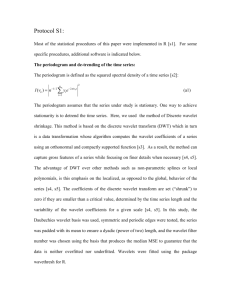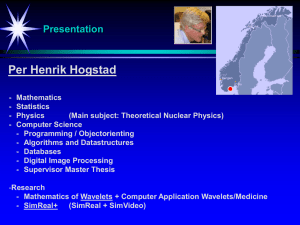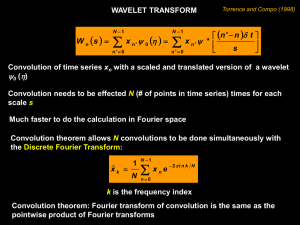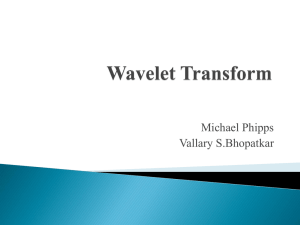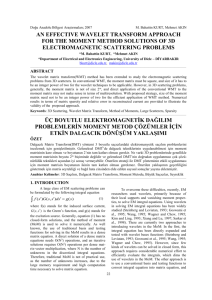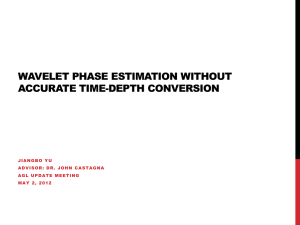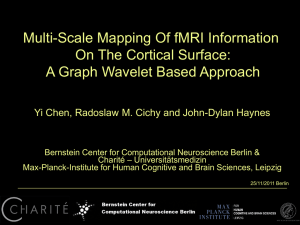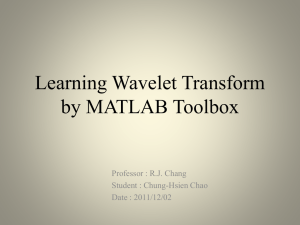Wavelet Spectral Analysis: Theory & Applications
advertisement
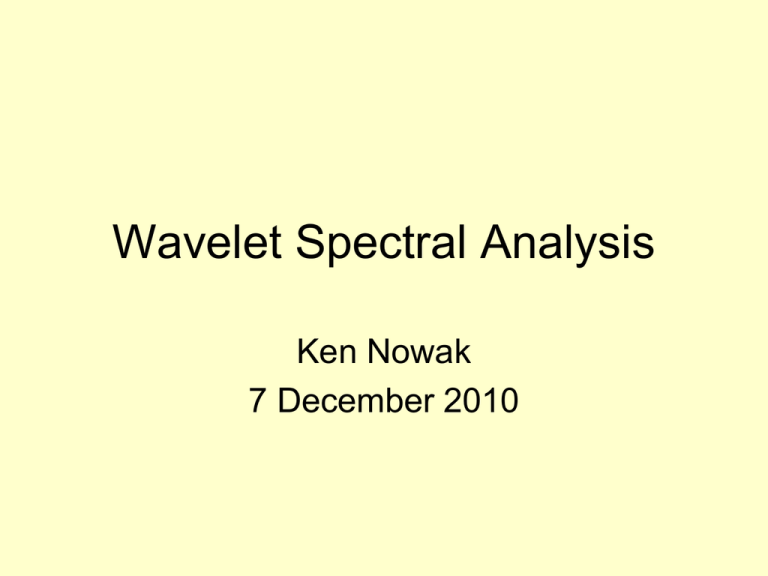
Wavelet Spectral Analysis
Ken Nowak
7 December 2010
Need for spectral analysis
• Many geo-physical
data have quasiperiodic
tendencies or
underlying
variability
• Spectral methods
aid in detection
and attribution of
signals in data
Fourier Approach Limitations
• Results are limited to global
• Scales are at specific, discrete intervals
4
2
0
Power
6
8
– Per fourier theory, transformations at each
scale are orthogonal
0.0
0.1
0.2
0.3
Frequency
0.4
0.5
Wavelet Basics
Wf(a,b)=
∫ f(x) y(a,b) (x) dx
Function to analyze
Wavelets detect
non-stationary
spectral
components
Morlet wavelet with a=0.5
b=2
b=6.5
b=14.1
Integrand of wavelet transform
|W(a=0.5,b=6.5)|2=0
|W(a=0.5,b=14.1)|2=.44
graphics courtesy of Matt Dillin
Wavelet Basics
• Here we explore the Continuous Wavelet
Transform (CWT)
– No longer restricted to discrete scales
– Ability to see “local” features
Mexican hat wavelet
Morlet wavelet
Global Wavelet Spectrum
function
Global
wavelet
spectrum
Wavelet
spectrum
a=2
|Wf (a,b)|2
a=1/2
Slide courtesy of Matt Dillin
Wavelet Details
• Convolutions between wavelet and data can
be computed simultaneously via convolution
theorem.
t b
1 / 2
Wavelet transform
X ( a, b) a
xt * ( a )dt
( ) 1/ 4 exp(i 0 ) exp( 2 / 2)
Wavelet function
N 1
X t (a ) xˆ kˆ * (a k ) exp( i k t t )
k 0
All convolutions at
scale “a”
Analysis of Lee’s Ferry Data
• Local and global wavelet spectra
• Cone of influence
• Significance levels
Analysis of ENSO Data
Characteristic ENSO timescale
Global peak
Significance Levels
1 2
Pk 1 2 2 cos(2k / N )
Background Fourier spectrum for red
noise process (normalized)
Square of normal distribution is chi-square distribution, thus the 95%
confidence level is given by:
2
k
v
P /v
Where the 95th percentile of a chi-square distribution is normalized by the
degrees of freedom.
Scale-Averaged Wavelet Power
• SAWP creates a time series that reflects
variability strength over time for a single or
band of scales
X
2
t
j t
C
2
j2
X t (a j )
j j1
aj
Band Reconstructions
• We can also reconstruct all or part of the
original data
J { X ( a )}
t
j
j
xt
1/ 2
(
0
)
j
0
y
C 0
aj
1/ 2
t
Lee’s Ferry Flow Simulation
• PACF indicates AR-1 model
• Statistics capture observed
values adequately
• Spectral range does not reflect
observed spectrum
Wavelet Auto Regressive Method
(WARM) Kwon et al., 2007
WARM and Non-stationary
Spectra
Power is smoothed across time domain instead of being concentrated
in recent decades
WARM for Non-stationary
Spectra
Results for Improved WARM
Wavelet Phase and Coherence
• Analysis of relationship between two data
sets at range of scales and through time
Correlation = .06
Wavelet Phase and Coherence
Cross Wavelet Transform
• For some data X and some data Y,
wavelet transforms are given as:
W
x
n
y
( s ),W n ( s )
• Thus the cross wavelet transform is
defined as:
W
xy
n
( s ) W n ( s )W n ( s )
x
y*
Phase Angle
• Cross wavelet transform (XWT) is complex.
• Phase angle between data X and data Y is
simply the angle between the real and
imaginary components of the XWT:
tan (
1
(W ( s ))
xy
n
)
(W ( s ))
xy
n
Coherence and Correlation
• Correlation of X and Y is given as:
x
E X x Y y
cov(X , Y )
x y
y
Which is similar to the coherence equation:
1
2
xy
n
s W ( s)
1
x
n
s W ( s)
2
1
y
n
s W ( s)
2
Summary
• Wavelets offer frequency-time localization
of spectral power
• SAWP visualizes how power changes for
a given scale or band as a time series
• “Band pass” reconstructions can be
performed from the wavelet transform
• WARM is an attractive simulation method
that captures spectral features
Summary
• Cross wavelet transform can offer phase
and coherence between data sets
• Additional Resources:
• http://paos.colorado.edu/research/wavelets/
• http://animas.colorado.edu/~nowakkc/wave



